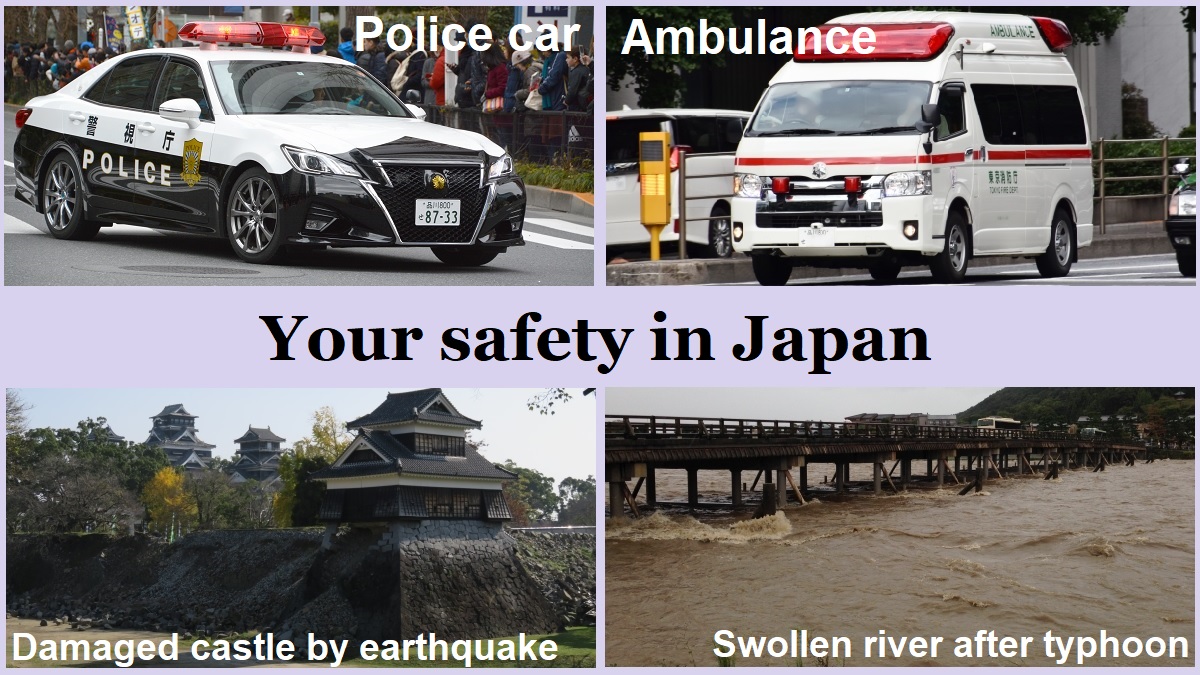About your safety while traveling in Japan
Security in Japan
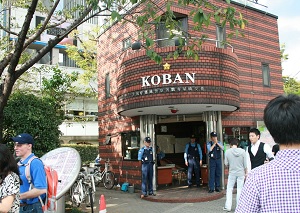
Koban near Ginza in Tokyo
They say that Japan is one of the safest countries in the world.
Surely the crime rate of Japan as defined by the United Nations is less than half of main Western countries.
If a case of purse-snatching or pickpocket has caused, even it is reported on local news in Japan.
I myself never have come such unlucky case in my life.
Even if you have dropped your wallet somewhere, you have the possibility to get back it.
Because, if a good person finds it fortunately, the person brings it to Koban.
Koban is the police box in any town of Japan.
The police keeps it until the owner come to get back.
If you have found trouble, visit the nearest Koban first.
Civilians in Japan are prohibited from possessing guns by law.
So, the incident of firing a gun is rare in Japan.
There is hardly dangerous town or slum in Japan.
You can walk around safely whole of Japan. And degree of safety about going out at night is higher than other countries.
In addition, if you have had a traffic accident or gotten caught up in a theft and an injury case, call the police at once.
The telephone number of police is "110".
And, if you have found a fire, call the fire engine at once.
The telephone number of fire station is "119".
Injury and illness in Japan
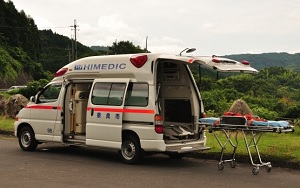
Ambulance in Japan
Unfortunately, if you have taken sick or gotten injured in Japan, you may need to consult a doctor.
In that case, go to a hospital.
If the condition is serious, call the ambulance.
The telephone number of ambulance is also "119". (Ambulance is in fire station.)
You can search the hospital handling your languages.
When you must go to any hospital, please check the following websites.
If you have consulted a doctor, you must pay expensive cost of the treatment and medicines.
If you must stay in the hospital for some days, the cost will go up.
As a rough indication, an easy medical treatment and medicine is about 10,000 to 20,000 yen.
If you must stay in the hospital, the cost may be over 50,000 yen a day.
Therefore, you should take out any travel insurance before the travel to Japan.
Typhoon
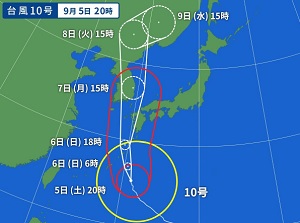
A predicted course of a typhoon in a weather report (Typhoon No.10 on Sep.5, 2020)
There is the vast Philippine Sea and Pacific Ocean to the south of Japan.
Near the equator of Western Pacific Ocean, more than twenty typhoons develope every year.
Some of them move toward the north and hit Japan.
Most of them come between July and September.
Like hurricane and cyclone, fierce storm causes damage in wide area.
The weather forecasts on TV and radio say early about detailed information of the typhoon which has a possibility to come to Japan.
Pay attention to the weather forecast when you visit Japan in this season.
If a typhoon is coming, it causes traffic confusion in wide areas in Japan.
Probably you may be forced to change your travel schedule.
By the way, each typhoon has a name of person in most countries, but the ordinal number in the year is given to the typhoon in Japan.
Earthquake
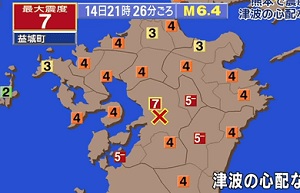
The report of earthquake in Kyushu on TV (About 30 minutes after a great earthquake, Apr.14, 2016)
Japan is an earthquake nation.
In fact, some small earthquakes occur somewhere in Japan every day.
The earthquake that people feel the shaking occurs several times a month, and strong earthquake occurs every a few years.
According to plate tectonic theory, four huge plates adjoin just under Japanese islands.
They are pressing each other and large earthquakes occur when any part of the plate is broken.
It is said that about 10 percent of the earthquakes in the world occur around Japan.
Therefore, there is a possibility that you encounter an earthquake in any place even during a trip in Japan.
Japanese researchers have tried to predict when and where the next great earthquake will occur for a long time.
Especially, it is expected that great "Tokai Earthquake", "Nankai Earthquake" and "Tonankai Earthquake" along the southern coast of Japan will occur at the same time within 20 to 30 years.
They are the parts of a major border between two huge plates.
Past great earthquakes in the area occurred in the following years:
684, 887, 1096 & 1099, 1361, 1498, 1605, 1707, 1854, 1944 & 1946.
As above, the interval was about 100 to 150 years.
There were also the cases that a great earthequake led to the second earthequake in the nearby area in a short period.
Enormous damage is anticipated in the wide region.
The area includes very important cities in Japan for industry and distribution. (Shizuoka - Nagoya - Osaka - Kochi)
Therefore, the network of seismic stations is installed in this area.
But the prediction of earthquake is very difficult.
So a new system for disaster prevention started in 2007.
When the system has caught the precedent earthquake wave, it sends automatically the alarm of earthquake generation to broadcast station.
And TVs and radios tell the alarm to people at the same time.
Recently, various smartphone applications catching the alarm are distributed.
Many people can know the alarm of earthquake by mobile terminal.
The actual quake is slower than the precedent wave.
Therefore, people can assure own safety during a few seconds before the actual quake starts.
When an earthquake has occurred during your travel, there is no way to run.
Wait there until the quake stops with attention to falling objects.
Most Japanese people are nerveless when an earthquake has occurred.
You must not lose your cool.
Most buildings in Japan have superior earthquake resistance in the world.
Anybody (Attendant of hotel, station and so on) certainly leads you to safe place.
Generally, the scale of earthquake is expressed in magnitude.
In Japan, the scale of the quake on each place is expressed in the rank 0 to 7 in terms of disaster prevention.
After a great earthquake has occurred, the programs of all TVs and radios change to the report of the eartquake within a few minutes.
And they show the info of the ranks of the quake at many points around the seismic center.
| Rank | Condition | Damage | Frequency |
|---|---|---|---|
| 0 | Imperceptible to people. | No | Some times a month |
| 1 | Felt by only some people in the building. | No | |
| 2 | Felt by most people in the building. Some people awake. | No | |
| 3 | Felt by most people in the building. Some people are frightened. | Rare | |
| 4 | Many people are frightened. Some people try to escape from danger. Most sleeping people awake. | A little | Some times a year |
| 5- | Most people try to escape from a danger. Some people find it difficult to move. | Some | A few times a year |
| 5+ | Many people are considerably frightened and find it difficult to move. | Some | |
| 6- | Difficult to keep standing. | Large | Once in a few years |
| 6+ | Impossible to keep standing and to move without crawling. | Great | |
| 7 | Thrown by the shaking and impossible to move at will. | Enormous | A few times in a century |
Recent severe earthquakes of rank 7 are the following.
In the 21st century, the frequency of strong earthquake is increasing.
Jan.17, 1995 : Around Kobe city (Great Hanshin Awaji Earthquake)
Oct.6, 2000 : Tottori
Oct.23, 2004 : Niigata
Mar.11, 2011 : Great East Japan Earthquake [earthquake and tsunami]
Apr.14 & 16, 2016 : Kumamoto
Sep.6, 2018 : Hokkaido
Jan.1, 2024 : Noto Peninsula [earthquake and tsunami]
Tsunami after great earthquake
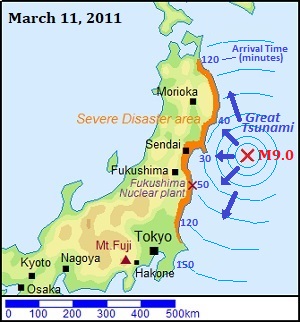
The Great East Japan Earthquake on March 11, 2011
Tsunami is originally a Japanese word.
Japanese people have had damage from tsunami many times since ancient times.
When a great earthquake occurs under the sea, the bottom of sea moves suddenly because of great destruction of underground.
It causes huge waves on the surface of the sea and the waves spread in all directions.
It is tsunami.
The wavelength is much longer than general wave by wind, and is from several kilometers to several hundreds of kilometers.
Therefore, tsunami has strong power and fast speed.
After the tsunami has reached the coast, the wave runs on the land without weakening the power and the speed.
The speed is faster than car and the wave catches up with running people.
The power destroys all buildings and houses easily.
The Great East Japan Earthquake occurred on March 11, 2011.
The scale of the earthquake was M9.0, and it was one of the strongest earthquakes in the world since the 19th century.
The rank of the strong quake in main cities was the following.
Rank 7 = Kurihara city (in Miyagi Prefecture)
Rank 6+ = Sendai, Utsunomiya
Rank 6- = Koriyama, Mito, Narita
Rank 5+ = Fukushima, Morioka, Nikko, Tokyo
In addition, the rank was 4 even in Nagoya and Sapporo more than 600 km away from the epicenter, and the rank was 3 in Kyoto and Osaka more than 800 km away.
The distance between the center of the earthquake and the nearest coast of mainland is over 200 kilometers.
But the tsunami reached within 30 minutes after the earthquake.
Along the nearest coast of the epicenter, the tsunami waves more than 15 meters high attacked, and the range of the coast was over 300 km.
In some narrow bay, the height of the tsunami was over 40 meters.
The number of dead or missing persons reached about 18,400, and over 90 percent of them are by tsunami.
If you are around coast and strong earthquake has occurred, run toward any high place soon.
For example, a hill, a mountain, a tall and strong building. The height is over 20 meters at least.
Radiation by the accident of Fukushima nuclear power plant
There is Fukushima nuclear power plant on the east coast of Fukushima Prefecture.
The tsunami of the Great East Japan Earthquake flooded the plant.
At that time, all power units to cool nuclear fuel were destroyed.
Then, the temperature rose and three buildings housing reactors were damaged by hydrogen explosions.
As a result, a large amount of radioactive material scattered in a wide area.
That is the accident of Fukushima nuclear power plant.
A tiny percent of radioactive material reached various area in eastern Japan.
In some towns, radiation was detected at a few local places.
In Tokyo about 250 km away from the plant, radiation was detected in mud of a water plant.
In wide area around the nuclear plant, decontamination works such as removing polluted soil have been done for some years.
It is done for some time in the future.
The level of radiation has already been back to normal except the surrounding area of the nuclear plant.
The west half of Honshu, Hokkaido, Shikoku and Kyushu Islands were quite safe even after the accident.
I heard that some foreign people believed that whole Japan had been contaminated by radioactivity.
But it isn’t true.
We living in Japan continue normal life without regard to radiation every day.
Please check the amount of radiation in various cities. (Sep.2020)
(The unit is μSv/h. Of course, lower value is better.)
Worst polluted area = 3.00 - 7.00
Fukushima city (about 60 km northwest from nuclear plant) = 0.04 - 0.14
Iwaki city (about 40 km south from nuclear plant) = 0.03 - 0.08
Tokyo = 0.03
Sendai = 0.04
Sapporo = 0.04
Kyoto = 0.06
Hiroshima = 0.05
Fukuoka = 0.06
Okinawa = 0.04
Please contrast them with the main cities in the world.
Seoul (South Korea) = 0.12
Beijing (China) = 0.07
Hong Kong = 0.08
Singapore = 0.10
New York (USA) = 0.04
Paris (France) = 0.04
London (UK) = 0.11
Japan is one of the countries that amount of radiation is low.
Even Fukushima city near nuclear plant is a little higher than many main cities in the world.
Rather, when you go on an overseas trip, you are exposed to dozens of times higher radiation in the airplane than the ground.
It is a need-to-know thing about radiation.
Japan is no problem.

